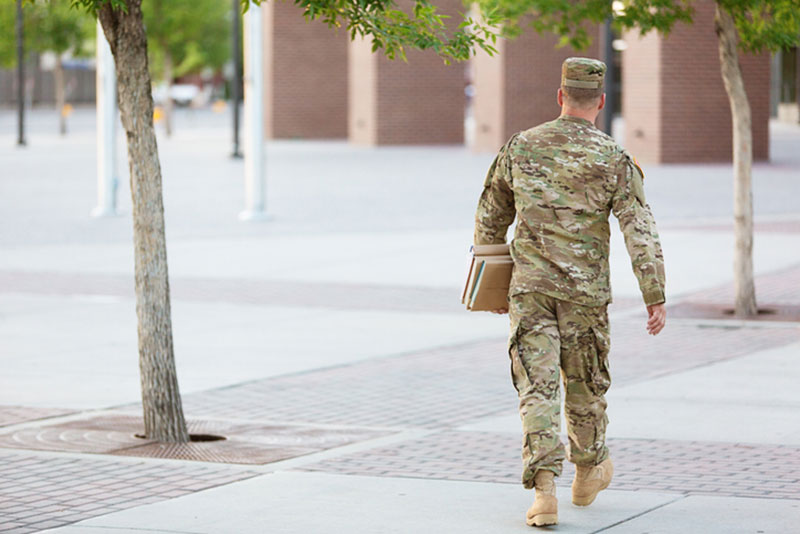
The appearance of U.S. Department of Defense (DoD) visual information does not imply or constitute DoD endorsement.
You don’t need anyone to tell you that being in the military is hard work. Your service came with challenges every day. You worked long hours, didn’t get enough sleep. You were held to high standards and got smoked when you didn’t meet them. Some of you spent an unfortunate amount of time getting shot at or showered with RPGs. And after all that, paperwork… forms and bureaucratic red tape to fill out at every rank and each duty station.
Some people claim they would prefer taking fire to filling out Operational Risk Management forms.
Hard work in America means big rewards. And for you, that means taking advantage of post-discharge military education benefits.
Your military college benefits might have been on your radar when you signed your enlistment contract. Or maybe after a few years of humping a pack around some of the less pleasant parts of the world, you realized that getting a college education would be a great way to avoid having to do that sort of thing anymore.
Either way, now that you’ve decided to attend college, you have got one more big hill to take: deciphering your VA education benefits.
But you have got plenty of fire support for this mission. Our website offers the easiest, fastest way to help you decipher what VA educational benefits you and your family are eligible for, no matter when or where you served.
What VA and DoD Education Benefits Do I Qualify For?
U.S. military college benefits are some of the most generous in the world. The Department of Veteran’s Affairs accounts for around 5 percent of all federal agency spending, dropping around $200 billion in 2019 on health and education services.
Educational support accounted for about $12.6 billion of the VA budget in 2020.
That’s enough to pay for a lot of housing and tuition. And according to the VA, over a million vets take advantage of those programs each year.
There are a lot of different options depending on how and when you served. They can even differ based on choices you made while you were still enlisted. And some options exist for spouses and dependents to take advantage of education benefits programs, too.
You will often find you qualify to take advantage of several different benefit programs. And you might also find you fall into more than one of these buckets—there are plenty of current reservists who already put in their years of active-duty service, for example. It just means you have more options.
Let’s see what kind of benefits you may qualify for:
For Active-Duty Service Members:
- Are you currently serving on active-duty and did you enlist less than three years ago?
- Are you currently serving on active-duty and did you enlist more than four years ago?
- Are you currently serving on active-duty and did you enlist more than four years ago and have your pay reduced by $1,200?
For Veterans Discharged Honorably:
- Are you a former service member who was discharged honorably with at least 90 days of active-duty service after September 10, 2001?
- Are you a former service member who was discharged honorably with at least 90 days of service and had your pay reduced by $1,200?
- Are you a former service member with a Purple Heart or a service-related disability?
- VA Disability Benefits
- Montgomery GI Bill® Active-Duty (with $1,200 pay reduction)
- Post-9/11 GI Bill®
- Yellow Ribbon Program
For Reservists:
- Are you currently serving in the reserves or National Guard with at least a 6-year service obligation?
For Spouses and Dependents:
- Are you an active-duty or former service member looking for education benefits for your spouse or children?
- Are you the spouse or child of a service member who made the ultimate sacrifice?
If you don’t fall into any of those categories, don’t give up! Explore other opportunities you may have to take advantage of veteran’s benefits.
For Active-Duty Service Members Getting a Jump on College Before Discharge
 Military benefits for college don’t just come after you get that DD-214. And they don’t just come from the VA once you’ve earned your veteran status. The DoD is happy to send you to school while you are still in the Armed Services if it can make you better at your job.
Military benefits for college don’t just come after you get that DD-214. And they don’t just come from the VA once you’ve earned your veteran status. The DoD is happy to send you to school while you are still in the Armed Services if it can make you better at your job.
In general, the military pays for college while you are still on active-duty through the Military Tuition Assistance program, sometimes called DoD Tuition Assistance. That can cover up to 100 percent of your tuition expenses for rates up to $250 per semester hour, for a total of $4,500 per fiscal year. You have to be able to complete the program before discharge, which usually means taking advantage of these at least a year prior to your End of Active Service date.
This all gets more complicated with National Guard members or reservists, who may be eligible for either kind of military grants for college depending on their current status.
MTA can cover up to 100 percent of your college tuition as long as it doesn’t exceed $250 per credit hour or $4,500 per year.
 From day one of your service, you have access to a powerful tool that can help you map out the education that your military benefit programs will help you pay for.
From day one of your service, you have access to a powerful tool that can help you map out the education that your military benefit programs will help you pay for.
That’s DANTES, the Defense Activity for Non-Traditional Educational Support.
DANTES is available to service members in every branch as well as reservists and National Guard Members. It offers a whole portfolio of resources for training in every phase of your military career:
· Academic Skills Training
· College and Career Counseling
· College Selection Tools
· Tuition Assistance
· College Credit By Examination for military training
· Troops to Teachers Program
· Joint Services Transcripts
· Overseas Education Support
Some of those programs are run directly by DANTES, such as maintaining Joint Service Transcripts, while others, like online skills courses or credits by exam, are coordinated by DANTES through other providers. It’s one-stop shopping for a wide variety of different educational benefits programs in every branch.
DANTES can help you coordinate many of your active-duty or reserve training options, as well as lay the groundwork for your post-service studies.
For Active-Duty Service Members Eager to Use VA Education Benefits
 With both the MGIB-AD and the Post-9/11 programs, you can actually start drawing on your benefits before you are discharged. This is the VA’s Tuition Assistance Top-Up Program. The whole point of the program is to cover additional costs not covered under the standard Military Tuition Assistance program described above.
With both the MGIB-AD and the Post-9/11 programs, you can actually start drawing on your benefits before you are discharged. This is the VA’s Tuition Assistance Top-Up Program. The whole point of the program is to cover additional costs not covered under the standard Military Tuition Assistance program described above.
It’s only available under certain circumstances, and you should think carefully before taking advantage of it.
In the right circumstance, the Top-Up program can kick in the afterburners on your pre-discharge college training.
First, you have to be qualified to receive your GI Bill® benefits in the first place. That means filling all the usual criteria for service and the $1,200 payment if you’re opting in for the Montgomery GI Bill®.
You’ll find more info on the criteria for both GI Bill® options in the section below.
If you meet those criteria, you are allowed to use your GI Bill® benefits to cover any gap between what your DoD Military Tuition Assistance will cover and the actual costs of the college program you want to attend.
That can get you through some top-flight schools while still on active-duty with zero costs. But the catch is that, regardless of how much money the VA has to kick in to cover the gap, you are burning eligibility for every month you take advantage of Top-Up. Whether it’s $30 per credit or $300, each month of Top-Up you use is subtracted from your potential 36 months of post-discharge GI Bill® coverage.
Only you can decide if that makes sense in your educational plans, but make sure you factor it in so you aren’t caught short later!
VA Education Benefits Through the GI Bill®
For Veterans Discharged Honorably After a Specified Number of Years in Service
 As everyone knows, the GI Bill® is the big dog when it comes to veteran education benefits. It’s the major VA education benefit available to veterans today, and for the past nearly 80 years.
As everyone knows, the GI Bill® is the big dog when it comes to veteran education benefits. It’s the major VA education benefit available to veterans today, and for the past nearly 80 years.
The original GI Bill® was called the Servicemen’s Readjustment Act of 1944 and was aimed squarely at the returning waves of Greatest Generation soldiers, sailors and airmen being discharged after winning the Second World War.
The original GI Bill® expired in 1956, but it was so effective that it has been updated and extended several times since.
Today’s vets can rely on two of those updated programs – 1) the Post-911 GI Bill® and 2) the Montgomery GI Bill®.
 Most service members being discharged today will rely on the latest version of the GI Bill® to cover their VA educational benefits – the Post-9/11 GI Bill®. Chapter 33, as it’s also known, covers anyone who served on active-duty after September 10, 2001.
Most service members being discharged today will rely on the latest version of the GI Bill® to cover their VA educational benefits – the Post-9/11 GI Bill®. Chapter 33, as it’s also known, covers anyone who served on active-duty after September 10, 2001.
When the Post-9/11 GI Bill® Veteran’s Educational Assistance Act passed in 2008, it was designed to offer the same advantages to veterans that the Greatest Generation had after World War II.
The major features of the bill include:
- Up to 36 months of educational tuition benefits for approved programs with costs scaled to undergraduate public tuition rates in the state where you’re enrolling
- A monthly living stipend based on local housing costs at an E-5 pay grade (with dependents)
- An annual stipend to cover books, supplies, or other non-tuition fees
- Up to $2,000 to cover one-time licensing or certification testing
In most cases, service members will be eligible if they have:
- Completed a high school diploma or GED before applying
- Active-duty service on or after September 11, 2001
- Completed at least three months of active-duty service (at least 36 months required for full benefits eligibility) OR completed at least 30 days and were honorably discharged for a service-related disability OR received a Purple Heart and were honorably discharged after any time in service.
Although reservists or Guardsmen aren’t explicitly taken care of under Chapter 33, the high rate of activations during the Iraq and Afghanistan wars means most service members can probably tap into this program.
Congress passed legislation sponsored by Congressman Gillespie “Sonny” Montgomery, a retired major general, in 1984 that delivered a major revamp of military college benefits. Drafted as Chapter 30 of the Bill, it’s now customarily known as the Montgomery GI Bill®, named after its sponsor.
It can be used both for college courses and technical schools or apprenticeship programs. You have to front the payments, however. Money comes to you through reimbursement checks, not directly to colleges.
The Montgomery GI Bill® came in two parts. You can probably figure out the big difference from the names.
The Montgomery GI Bill® Active-duty (MGIB-AD)
MGIB-AD was designed to cover soldiers who had served on active-duty after 1985. It has a kind of cost-sharing component that requires participants to pay in $1,200 during their term of service to be eligible for benefits later. Most service members are offered the opportunity to deduct $100 from their first 12 paychecks, but paying the $1,200 in a lump sum before discharge is also an option.
Other qualifications include:
- You have a high school diploma, GED, or 12 hours of college credit
- You entered active-duty for the first time after June 30, 1985
- Your discharge was honorable
- You served for at least 3 years (or 2 if your initial contract specified that amount)
You get full military benefits after 4 years of service if you were in the 2 by 4 selected reserve program.
But you can get into the weeds really quick trying to determine eligibility for MGIB. It can also depend on:
- Your initial service contract
- Specific service dates
- Eligibility for previous programs (the Vietnam Era GI Bill®)
- Separation status
The MGIB offers up to 36 months of education benefits, covering tuition reimbursement of up to $2,150 per month.
MGIB benefits are time limited to 10 years after release from active-duty, but a number of extensions are available for hardship, disability, or other unavoidable circumstances.
 For members of the Selected Reserve, Chapter 30 also offers up to 36 months of benefits. The rate is lower, at only $397 per month. But you can take advantage of the program while you are still in the reserves or National Guard, and your eligibility will be extended if you are activated for some reason.
For members of the Selected Reserve, Chapter 30 also offers up to 36 months of benefits. The rate is lower, at only $397 per month. But you can take advantage of the program while you are still in the reserves or National Guard, and your eligibility will be extended if you are activated for some reason.
Like the MGIB-AD, you need to have entered service after June 30, 1985 and have a high school diploma or GED. Additionally, you must:
- Have a 6-year service obligation to the Selected Reserve
- If you are an officer, agree to a 6-year extension to your initial service obligation
- Have completed your initial active-duty for training
- Remain in good standing while serving in your reserve unit
Normally, not only can you use your MGIB-SR benefits while a reservist, but you must do so if you don’t want to lose them. Eligibility normally ends when you leave the reserve. But there are exceptions:
- If you were separated by a disability not caused by misconduct
- Your unit was deactivated between October 1, 2007 and September 30, 2014
- You were otherwise involuntarily separated during that same period
Since the MGIB requires a lot of thinking ahead and includes a lot of twists and turns, almost everyone who can will pick the other current GI Bill® option – the Post 9/11 GI Bill®…
Can I Use Both Montgomery and Post-9/11 GI Bill® Benefits?
 You might qualify for both Montgomery and Post-9/11 benefits, but as of now you can only pick one. And, like pushing down the trigger paddles on a Ma Deuce, it’s an irrevocable decision. There’s some hope that this could change though.
You might qualify for both Montgomery and Post-9/11 benefits, but as of now you can only pick one. And, like pushing down the trigger paddles on a Ma Deuce, it’s an irrevocable decision. There’s some hope that this could change though.
In mid-2021, the Federal Circuit Court decided that veterans who meet the requirements should be able to access benefits from both programs with some restrictions.
The VA challenged the decision, stoking a new battle in a years-long fight, but it’s possible we’ll see a final decision before the end of 2022.
We’ll keep you posted!
The Forever GI Bill® Changed VA Educational Benefits for the Better
 In 2017, Congress passed a tune-up of the Post-9/11 GI Bill® as well as several of the other veteran’s educational benefits listed here. The additional language had some important impacts that modify veteran’s educational assistance, including:
In 2017, Congress passed a tune-up of the Post-9/11 GI Bill® as well as several of the other veteran’s educational benefits listed here. The additional language had some important impacts that modify veteran’s educational assistance, including:
- Expanding benefits to Purple Heart recipients
- Eliminating a 15 year time limit on GI Bill® benefits
- Allowing Reserve Educational Assistance Program members to apply their service credit toward benefits
- Adding the monthly housing allowance
- Additional transfer of benefits options that allow dependents to pass along survivor benefits to other dependents (younger brothers or sisters, for example)
Although we include the Forever GI Bill® changes in our descriptions of these programs, they can add a number of different options that aren’t discussed here. It’s a great idea to check out the list of changes to see if any of them impact your college plans or opportunities. Everything from a new formula for housing allowance calculations to new STEM benefits to consolidated credit levels for partial service are on the plate.
For Spouses and Children of Eligible Service Members and Veterans
Dependents, such as spouses or children, may also receive Post-9/11 GI Bill® benefits if transferred to them by a qualifying service member or veteran.
There are a few hoops to jump through to transfer GI Bill® benefits to a spouse or dependent—it’s not automatic.
First, you need to qualify for Chapter 33 benefits in the first place. If you are only eligible under some other section of the bill, it can’t be transferred.
Second, you have to have at least 6 years of service under your belt before you even ask about a transfer. And you need to agree to sign up for an additional 4 years, for a total of 10. You have to do this while you are still on active-duty, or in the Selected Reserve.
Finally, your dependent has to enroll in the Defense Enrollment Eligibility Reporting System. That’s the DoD system that tracks both service members and others who may receive services related to the military, including TRICARE. So there is a good chance they are already in the system.
For Veterans and Eligible Family Members Interested in Private Universities, Out-of-State Schools, and Foreign Colleges
The Yellow Ribbon program offers a boost in your benefits to help you afford some kinds of schools that the GI Bill® itself might not entirely cover. Examples would be:
- Private schools with higher tuition and fees
- Foreign colleges
- Public colleges for which you don’t qualify for residential tuition rates
 The Yellow Ribbon program is a partnership between the VA and colleges or universities that accept it.
The Yellow Ribbon program is a partnership between the VA and colleges or universities that accept it.
Each participating school kicks in a certain amount toward covering the extra tuition and fees. The government then agrees to match that contribution, basically doubling the coverage.
As with the GI Bill® benefits, you have to meet certain standards for service length. Only Post-9/11 GI Bill® recipients can apply. Additionally, you need to meet at least one of these criteria:
- At least 36 months on active-duty
OR - Earned a Purple Heart or service-related disability discharge
OR - Be a dependent child of a transfer benefit
OR - Be a Fry Scholar
Also, the school you plan to attend has to meet certain qualifications and agree to participate in the program. Each school is also restricted to only a certain number of students that can be covered by the program. If they are already full, you can still attend, but you won’t qualify for the additional tuition assistance.
There are 2,000 colleges and universities worldwide that participate in the Yellow Ribbon Program, but only about 500 fully fund the program and don’t restrict the number of students allowed to access the benefits. This elite group of military friendly schools ensure every eligible student that applies can enroll under the Yellow Ribbon Program and that every single one of them has their tuition costs covered in full.
These are the schools we feature on our regional list of the Most Military Supportive Colleges in America:
The Most Military Supportive Colleges in the Northeast
Connecticut, Delaware, District of Columbia, Illinois, Indiana, Maine, Massachusetts, Maryland, Michigan, Missouri, New Hampshire, New Jersey, New York, Ohio, Pennsylvania, Rhode Island, Vermont, Wisconsin
The Most Military Supportive Colleges in the Southeast
Alabama, Arkansas, Florida, Georgia, Kentucky, Louisiana, Mississippi, North Carolina, South Carolina, Tennessee, Virginia, West Virginia
The Most Military Supportive Colleges in the Central U.S.
Colorado, Iowa, Kansas, Minnesota, Montana, Nebraska, North Dakota, Oklahoma, South Dakota, Texas, Wyoming
The Most Military Supportive Colleges in the Pacific Region
Alaska, Arizona, California, Hawaii, Idaho, Nevada, New Mexico, Oregon, Washington
For the Families of Fallen Service Members
In the most unfortunate circumstances, service members may not always be around to take advantage of the benefits they have earned. But there is peace of mind when heading off into danger in knowing that your survivors will be taken care of if the worst happens.
That’s what Chapter 35, the Survivors and Dependents’ Educational Assistance Program is for.
This is also a post-9/11 program. To be eligible, you must be a child or spouse of a service member who meets one of these criteria:
- Died in the line of duty after September 10, 2001
OR - Is MIA or detained or captured in the line of duty
OR - Is hospitalized or in treatment for a service-connected disability that is likely to result in discharge
This program is different from benefits that are transferred under the Post-9/11 GI Bill®.
You can receive up to $1,298 in monthly benefits for 36 months. Spouses of eligible service members have 20 years from the date of death of the service member or 10 years from the date they are otherwise qualified by the VA. Children can use the benefits between the ages of 18 and 26, with no other limits.
 In addition to Chapter 35 benefits, and with overlapping eligibility, you have the Fry Scholarship program. Open to spouses and children of service members who died in the line of duty on or after September 11, 2001, Fry Scholarships offer 36 months of benefits as well.
In addition to Chapter 35 benefits, and with overlapping eligibility, you have the Fry Scholarship program. Open to spouses and children of service members who died in the line of duty on or after September 11, 2001, Fry Scholarships offer 36 months of benefits as well.
While the DEA offers a fixed monthly payment, Fry Scholarships cover either the full in-state costs of tuition at public schools, and up to $26,042.81 per year at private or foreign schools (an amount that may be adjust sometimes).
Other differences with the Fry Scholarship include:
- Coverage up to $1,000 per year for books and supplies
- A basic monthly housing allowance similar to the Post-9/11 benefit
- Can be used up to age 33, or with no age limit for those eligible after 2013
You do have to choose between Fry and DEA program benefits. You might notice some similarities between the Fry Scholarship and Chapter 33 benefits; that’s because the Fry Scholarship were designed to cover an unfortunate gap in the Chapter 33 transferability—deceased members couldn’t apply for transfers. So the Fry Scholarship basically extends that option to survivors.
The Transition Assistance Program Offers the Tools You Need to Plan for Civilian Life
For All Service Members Interested in Taking Advantage of VA Education Benefits
A lot of the troubles that lead to the need for the original GI Bill® came from the military not doing enough to prepare soldiers for civilian life before discharge. But those days are over, thanks to TAP, the Transition Assistance Program.
TAP is a cooperative effort with a lot of heavy hitters in the federal lineup taking part. It includes contributions from:
- Department of Defense
- Department of Education
- Homeland Security
- Department of Labor
- Veterans Affairs
- Small Business Administration
- Office of Personnel Management
About 200,000 veterans are discharged each year and TAP is now mandatory for every single one of them.
You have probably had your fill of mandatory assemblies and counseling by this point in your military career, but this is one you’re going to want to stay awake for.
TAP offers the keys to help you unlock all your other veteran’s benefits, before you need them.
TAP helps walk you through all your benefits options, including eligibility. You’ll go through a one-on-one counseling session with a professional counselor and take a class covering VA benefits. You’ll have the option of attending two-day workshops to give you a sense of what kind of training you might want to pursue. You can choose tracks such as:
- Employment Fundamentals of Career Transition
- Wounded Warrior and Caregiver
- Department of Labor Employment Workshop
- Career and Credential Explorer
This all kicks in a full year before your estimated date of separation, so you have plenty of time to soak it in. A capstone process that happens 90 days before separation ensures that you meet TAP Career Readiness Standards.
Each branch is responsible for conducting TAP for their own service members, so the process is slightly different. Check with your command for details.
If you became disabled in the line of duty, you have the whole massive structure of the VA working to offer ongoing care. That’s just how it works.
In the American military, no one is left behind.
In terms of VA benefits, education might be one of your lowest concerns. Disability really only comes into consideration for military college benefits when it comes to eligibility—otherwise, you get the same kind of coverage as anyone else.
But there are various VA disability benefits that can work to your favor when you decide to take advantage of the GI Bill®, even if they aren’t a part of it:
Veteran Readiness and Employment
This program is designed to help disabled vets get back to work. In today’s job environment, that increasingly means offering tuition and accommodation assistance. VR&E helps you develop a career plan and then get the training and assistance you need to make it happen. This can stack with your GI Bill® educational benefits, too.
Disabled Veteran Housing Assistance
The VA offers grants for helping to adapt your housing to accommodate your disability—important if you need assistance to allow you to study comfortably at home
VA Disability Compensation
If you qualify for these monthly payments, they don’t specifically go to your college tuition—but you can definitely use them to pay toward tuition, living expenses, or any other costs related to life and school attendance
VA Healthcare
Again, healthcare isn’t a need that is specific to college students. But healthcare during college, before most people are eligible for employer-based health insurance, is always a concern. And many vets will have aged out of eligibility for their parents’ coverage, so VA disability healthcare coverage is a big deal for peace of mind while attending university
Some disability compensation is also available to surviving spouses or children of veterans who pass away while covered by the program.
What About State-Level Military College Benefits?
The Veteran’s Benefits Administration is the biggest single resource for military college benefits. But the country’s appreciation for your service doesn’t stop at the federal level. You will also find that many states offer their own separate veteran’s education benefit programs.
These benefits almost always are available on top of your VA education benefits. That makes them a serious force multiplier for your education.
Every state is different though. Some are mostly concerned with taking care of members of their own National Guard units; others offer opportunities to any veteran who is a resident. Check your own state for details.
What if you didn’t quite qualify for any of the standard programs we outlined here? Maybe you were separated without an honorable discharge, or you somehow think you fell between the cracks.
Don’t give up! It turns out that there are a ton of obscure exceptions that might still allow you to tap into these great VA education benefit programs.
For example, there’s an exception carved out in the Post-9/11 GI Bill® for reservists who had been participating in the Reserve Education Assistance Program when it ended in 2015. Even if you weren’t on active-duty, you could qualify for Chapter 33 benefits!
And there are a lot of smaller programs you might be eligible for, like the National Call to Service program, or the Veterans’ Educational Assistance Program.
Guess what? If you were an airman with a 46130 specialty rating who enlisted for the first time between December 1, 1980 and September 30, 1981, in tiny Beckley, West Virginia, you are eligible for VEAP!
If you think you might be eligible for one of these more obscure benefits programs, you might find the requirements looking more like encrypted signals traffic than anything else. But decoding those requirements can lead to bigger opportunities. For example, some people who can establish that they have VEAP eligibility remaining can then use that to qualify for MGIB or Post-9/11 benefits.
The military taught you perseverance. Exploring every possible option to get your veteran’s benefits is a good place to use that grit and determination.
VA Education Benefits Are Constantly Evolving
 One final thing: your VA education benefits are subject to change.
One final thing: your VA education benefits are subject to change.
Because they are enacted into law by Congress, all these programs can also be changed by Congressional legislation. In fact, part of the reason the system is so complicated today is because it has been tinkered with along the way. A lot of the complicated eligibility requirements come from Congress making adjustments after the fact to catch service members who were accidentally falling through the cracks.
So it pays to keep your eye on what’s happening in Washington. If you aren’t eligible for a particular benefit right now, that can change next month or next year.





